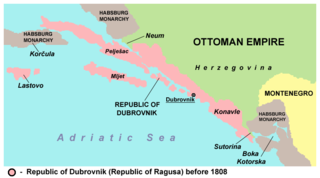Loading AI tools
Extinct Romance varieties of Dalmatia From Wikipedia, the free encyclopedia
Dalmatian or Dalmatic (Italian: dalmatico; Croatian: dalmatinski) was a group of Romance varieties that developed along the coast of Dalmatia. Over the centuries they were increasingly influenced, and then supplanted, by Croatian and Venetian.[1]
You can help expand this article with text translated from the corresponding article in Russian. (May 2024) Click [show] for important translation instructions.
|
| Dalmatian | |
|---|---|
| Region | Dalmatia |
| Extinct | 1898 (if Tuone Udaina was the last speaker) |
| Language codes | |
| ISO 639-3 | dlm |
dlm | |
| Glottolog | dalm1243 |
| Linguasphere | 51-AAA-t |
 | |
It has not been demonstrated that Dalmatian belonged to a larger branch of Romance or even that its varieties constituted a valid genetic grouping of their own.[2]
This was spoken in Dubrovnik (Italian: Ragusa). Various Ragusan words are known from local documents in Latin and Venetian. One such document, for instance, records the words pen, teta, chesa, fachir and indicates the meanings 'bread', 'father', 'house', 'to do'.[3] There are also some 14th-century texts in Ragusan, but these show extensive Croatian and Venetian influence, to the point that it is difficult to discern which if any of their features are genuinely Dalmatian.[1]
A notable feature of Ragusan was its preservation (without palatalisation) of Latin /k/ and /ɡ/ before front vowels, which can be seen in attested forms like colchitra < Latin CULCITRA.[4]
In the Republic of Ragusa, official business was conducted in Ragusan until approximately the end of the 15th century. In 1472 the Senate famously banned the use (without permission) of "Slavic" or "any language other than Ragusan or Italian" for conducting legal disputes. Another piece of evidence is a letter by Elio Lampridio Cerva (1463–1520) that mentions "I remember how, when I was a boy, old men would carry on legal business in the Romance language that was called Ragusan".[5]

This was spoken in Krk (Italian: Veglia, Dalmatian: Vikla[6]). It is documented from the 19th century, in large part thanks to the efforts of the linguist Matteo Bartoli and his informant Tuone Udaina. When they first met, Udaina had not spoken Vegliote in two decades and could only produce a sort of 'Dalmatianised' Venetian.[7] As their interviews went on, he was able to recall more and more Vegliote from his youth, albeit in a form still tinged by his Venetian.[1]
Like Ragusan, Vegliote did not participate in the broader Romance palatalisation of [k] and [ɡ] before front vowels. (Compare Vegliote [ɡeˈlut] "cold" and Italian [dʒeˈlato] < Latin GELATUM.) Nevertheless it appears to have undergone a later, and independent, palatalisation of [k] to [tʃ] before the sounds [j i y], as in the word [tʃol] "arse" < *[kyl] < *[ˈkulu] < CULUM.[8]
It was once thought that Vegliote, like Romanian, showed the sound-change /kt/ > /pt/, but the only example of this is /ˈwapto/ "eight" < OCTO, which was probably affected by analogy with /ˈsapto/ "seven" < SEPTEM.[9]
From Udaina.[10] Stress-marks have been omitted.
Dalmatian would also have been spoken on major islands and in towns along the Adriatic coast, namely Cres, Rab, Zadar, Trogir, Split, Kotor.[1]
Likely 'Dalmatisms' in Croatian include:[11]
Seamless Wikipedia browsing. On steroids.
Every time you click a link to Wikipedia, Wiktionary or Wikiquote in your browser's search results, it will show the modern Wikiwand interface.
Wikiwand extension is a five stars, simple, with minimum permission required to keep your browsing private, safe and transparent.